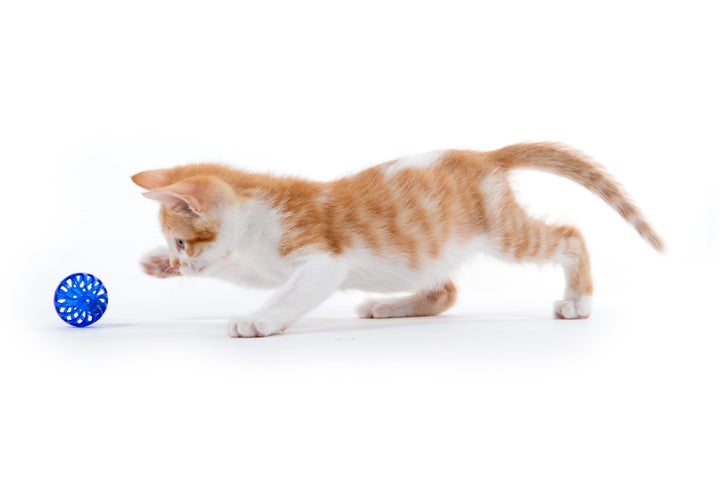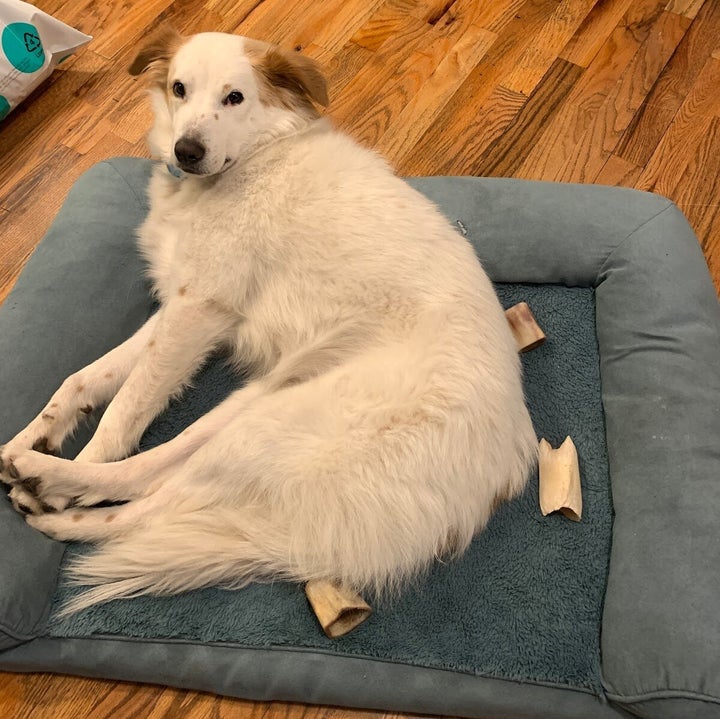My dog Gussie is a power chewer. She destroys the playthings I get for her, gnawing plastic bones down to nubs and gutting plush toys. I hadn’t given much thought to whether she was ingesting particles from these toys ― until I began to spot little pieces of plastic in her poop.
We know we should be concerned about plastics: Research shows that its production and disposal are making climate change worse, and that it can be devastating to wildlife and might be bad for our health.
Since a lot of pet toys are made out of plastic, should we also be worried about plastic and our pets?
It can be difficult to refrain from buying our pets shiny new gifts. Pet toys are a $1 billion industry (sheesh!), and research reinforces the idea that pet parents treat their four-legged friends as they would a human child. Some parents take extra care to research kids toys before buying them; doing the same for your dog or cat can’t hurt.
When it comes to plastic and pet health, there aren’t many straightforward answers. But arming yourself with information about the materials in a toy — and knowing how rough your pet may get with it — are important things to consider before you buy.

Since there’s still a lot of research needed to determine plastic’s impact on human health, you can bet that there’s not a ton of conclusive info about the material’s effects on pets. And pet companies aren’t held to nearly the same safety and quality standards that, say, kids toy companies are. Still, you can try to offer some measure of quality control for pet toys, says Katy Nelson, resident veterinarian at Freshpet.
“Always buy American-made, as we have stricter standards for what goes into our products than some companies mass-producing products overseas,” Nelson told HuffPost.
She also recommended choosing toys that are labeled “washable,” as “this ensures they’re made of safe materials and are able to be cleaned to prevent the spread of germs in your house.”
A common chemical used in plastic production that might be a cause for concern among pet owners is BPA, aka bisphenol A. “Products for pets should be BPA-free, but that is not always the case,” Nelson said.
According to the Centers for Disease Control and Prevention, studies have linked BPA with possible fertility issues in lab animals, though more research is needed to understand its human health risks. The Food and Drug Administration says that BPA exposure is mostly safe (the agency has expressed some concern about its potential effects on fetuses and babies), but independent experts don’t necessarily agree.
A study conducted by researchers at Texas Tech University found that aging and worn dog toys contained increased concentrations of both BPA and phthalates, a group of chemicals that can make plastic more flexible and durable. Phthalates, too, have been associated with concerns around fertility.
“The interaction of pet health and environmental chemicals is understudied,” said Kimberly Wooten, one of the study authors. “What may be a safe dose for one species isn’t always a good measure for another species. But the amount of BPA and phthalates we found from the bumpers [a specific type plastic toy often used to train retrievers] would be considered on the high end of what you might find in children’s toys.”

Even toys made from BPA-free plastic can be risky for your dog or cat, especially if they’re a toy assassin like my Gussie.
“Toys made of hard plastic can cause damage to the gums if chewed vigorously, and softer toys can be an ingestion risk,” said Nelson, adding that knowing your dog’s chewing and play style can help you determine what kind of toys are best for her. “A squeaky plastic flamingo might be cute, [but] it could pose a risk to your pet if too easily destroyed or ingested,” said the veterinarian.
Even if you think you’re buying a toy free of plastic, things aren’t always as they seem.
The squeakers found inside plush toys are often made from plastic. (I’ve seen my dog’s tenacious jaws surgically remove these from the center of squeaky stuffed animals). And stuffing materials tend to be made of polyester fiber fill, which happens to be a type of plastic used in toys for both humans and pets. Whether this material contains toxins or not depends on its source; even if it’s toxin-free, however, it’s not a good thing for your pet to be ingesting stuffing, as this can lead to digestive issues. Bits of hard plastic can be rough on your furry friend’s GI tract, too, said Nelson.
Some people try to get around all these challenges by making their pet’s playtime plastic-free.
Look for toys made out of natural materials like hemp, canvas, natural rubber, bamboo or wool, suggests One Green Planet. The website compiled a list of eco-friendly dog toys you can buy, and some advice for making your own dog toys. (You could also try putting some worn socks in the freezer. Anecdotal evidence reveals that dogs really like to chew on these.)
According to Nelson, you still have to take your dog’s chewing style into consideration when choosing plastic-free products. “Aggressive chewers benefit from tougher products,” she said, naming hard rubber toys from Kong and Tuffy plush toys as examples.
“Consider puzzle toys and feeders for the more intelligent breeds who also need mental stimulation, and know that they’ll always prefer playing with you rather than just a toy. Choose interactive toys that allow you to participate as well,” added Nelson.
Don’t worry, cat owners, there are plastic-free toys you can buy, too! And you can make your own scratching posts and kitty tents out of items you probably already have around the house.

